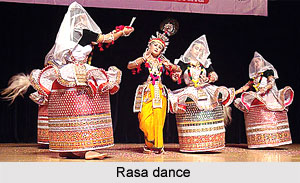In rasa dance of Manipur lie the richness of both Nritta and abhinaya of the Manipuri style. Here the art attains a certain level of perfection and stylization. These are compositions of a literary order set to classical music and performed to a given metrical cycle. King Bhagyachandra has composed three of the four rasa dances known to Manipur. A quick glimpse into the history of Rasa Dance will lead one to the love poetry of the Vaishnavite sages, such as, Chaitanya, Surdas, Jayadeva and others. These love ballads were set to music and later adapted to dance forms.
Time of Performance
There is the Vasantarasa for the full-moon day of Holi, and the Kunja rasa which is performed on the Rakhi-Purnima in the month of August. Then there is the Maha rasa which is performed on the full-moon day of the Karthika Purnima in the month of October-November. King Chandrakirti added the Nitya rasa, and gopa rasa. These dances follow a definite pattern which gives full scope for single performance. This dance of Manipur is performed in front of the temples. In temple premises, such as, Shri Shri Govindaji in Imphal Ras Lila is commonly performed during Krishna Janmashtami, Basanta Purnima and Karthika Purnima.
Literature of Rasa
The literature is Vaishnavite, simultaneously giving full scope to the actors to present the various nayikas of the Indian aesthetic tradition and the several Sthayi Bhavas mentioned in Natyashastra. Through the various episodes of the rasa a dominant mood called Karuna is created. By presenting a transitory state a configuration is produced of a dominant state of being. Through each sequence the dancers present several vyabhichari Bhavas. The various rhythms of the bhangis give full scope to the dancer to present variations on a given theme. The songs of Jayadeva from the Gita Govinda or Vidyapati's Padavali or the works of other poets of the Bhakti school are woven into the rasa dances.
For more, visit the link below:
https://www.indianetzone.com/1/raslila_different_indian_states.htm
